Discover 35 hidden attractions, cool sights, and unusual things to do in Kolkata (India). Don't miss out on these must-see attractions: New Market, Victoria Memorial, and Indian Museum. Also, be sure to include Science City in your itinerary.
Below, you can find the list of the most amazing places you should visit in Kolkata (West Bengal).
Table of Contents
New Market
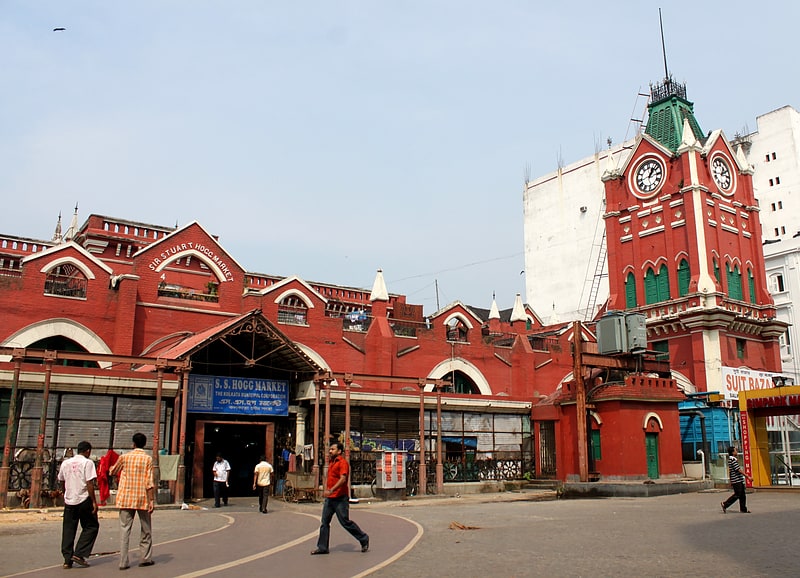
Shopping center in Kolkata, India. The New Market, formerly known as Sir Stuart Hogg Market, is a market in Kolkata situated on Lindsay Street, beside Free School Street. Although primarily "New Market" referred to the original enclosed market, today in local parlance, the entire shopping area is often known as "New Market".[1]
Address: Kolkata, Lindsay Street
Victoria Memorial

Also known as: विक्टोरिया मेमोरियल
Museum in Kolkata, India. The Victoria Memorial is a large marble building in Central Kolkata, which was built between 1906 and 1921. It is dedicated to the memory of Queen Victoria, now a museum under the auspices of the Ministry of Culture, and is the largest monument in the world which is dedicated to a royal. The memorial lies on the Maidan and is one of the famous monuments of Kolkata.[2]
Address: 1, Queens Way, 700071 Kolkata
Indian Museum
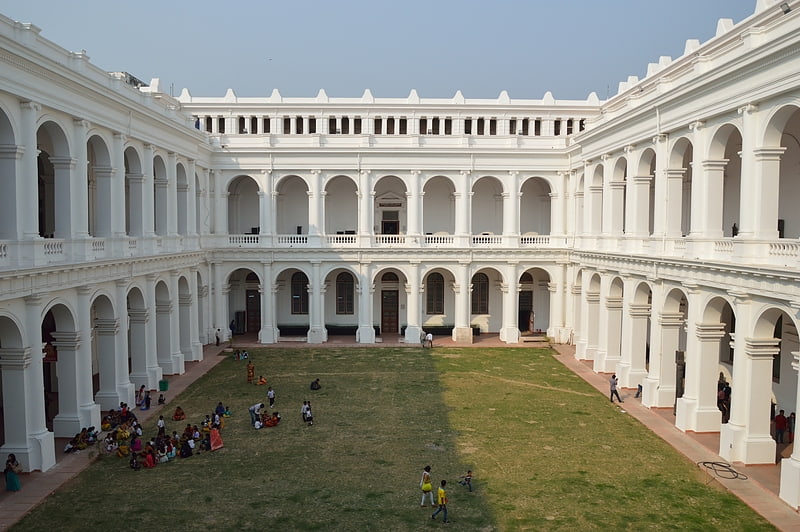
Also known as: भारतीय संग्रहालय
Cultural museum established in 1814. The Indian Museum in Central Kolkata, West Bengal, India, also referred to as the Imperial Museum at Calcutta in colonial-era texts, is the ninth oldest museum in the world, the oldest and largest museum in India. It has rare collections of antiques, armour and ornaments, fossils, skeletons, mummies and Mughal paintings. It was founded by the Asiatic Society of Bengal in Kolkata, India, in 1814. The founder curator was Nathaniel Wallich, a Danish botanist.
It has six sections comprising thirty five galleries of cultural and scientific artifacts namely Indian art, archaeology, anthropology, geology, zoology and economic botany. Many rare and unique specimens, both Indian and trans-Indian, relating to humanities and natural sciences, are preserved and displayed in the galleries of these sections. In particular the art and archaeology sections hold collections of international importance.
It is an autonomous organization under Ministry of Culture, Government of India. The present Director of the Indian Museum is Shri Arijit Dutta Choudhury who is also the Director General, NCSM and having the additional charge of Director General of National Library.
Administrative control of the Cultural sections, viz. Art, Archaeology and Anthropology rests with the Board of Trustees under its Directorate, and that of the three other science sections is with the geological survey of India, the zoological survey of India and the Botanical survey of India. The museum Directorate has eight co-ordinating service units: Education, preservation, publication, presentation, photography, medical, modelling and library. This multipurpose institution with multidisciplinary activities is being included as an Institute of national importance in the seventh schedule of the Constitution of India.[3]
Address: 27, Jawaharlal Nehru Rd, 700016 Kolkata
Science City
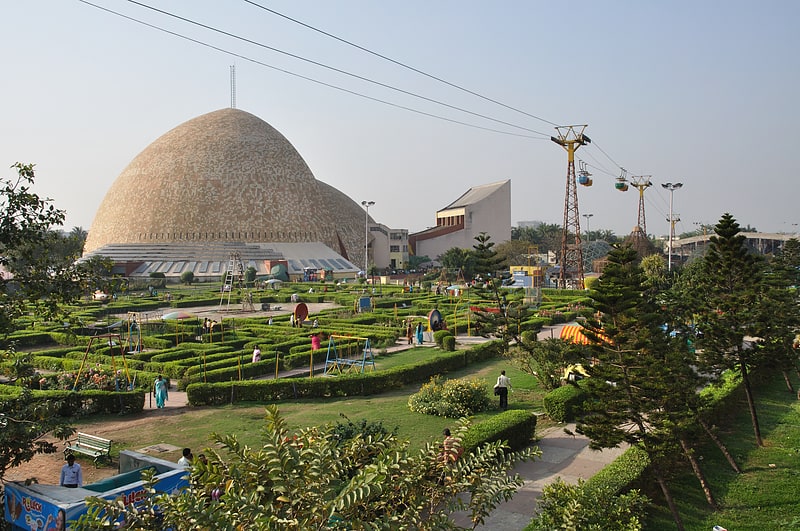
Also known as: विज्ञान नगरी, कोलकाता
Museum in Kolkata, India. Science City Kolkata is the largest science centre in the Indian subcontinent. It is managed by National Council of Science Museums, Ministry of Culture, Government of India. It is located at the crossing of Eastern Metropolitan Bypass and J. B. S. Haldane Avenue in East Topsia. Saroj Ghose, the first director general of NCSM, is credited with having conceptualised this centre in 1997. This centre was inaugurated by two parts: the ‘Convention Centre Complex’ was unveiled on 21 December 1996 by Paul Jozef Crutzen in presence of the then chief minister Jyoti Basu and the whole centre was opened by the then prime minister Inder Kumar Gujral on 1 July 1997. On 10 January 2010, prime minister of India, Manmohan Singh laid the foundation stone for the second phase of Science City in presence of the then chief minister of West Bengal, Buddhadeb Bhattacharjee.
It is an ideal place to visit and enjoy, great for science students.[4]
Address: J.B.S Haldane Avenue, 700046 Kolkata
Howrah Bridge

Also known as: रवीन्द्र सेतु
Cantilever bridge in Howrah, India. The Howrah Bridge is a balanced cantilever bridge over the Hooghly River in West Bengal, India. Commissioned in 1943, the bridge was originally named the New Howrah Bridge, because it replaced a pontoon bridge at the same location linking the two cities of Howrah and Kolkata. On 14 June 1965, it was renamed Rabindra Setu after the great Bengali poet Rabindranath Tagore, who was the first Indian and Asian Nobel laureate. It is still popularly known as the Howrah Bridge.
The bridge is one of four on the Hooghly River and is a famous symbol of Kolkata and West Bengal. The other bridges are the Vidyasagar Setu (popularly called the Second Hooghly Bridge), the Vivekananda Setu and the relatively new Nivedita Setu. It weathers the storms of the Bay of Bengal region, carrying a daily traffic of approximately 100,000 vehicles and possibly more than 150,000 pedestrians, easily making it the busiest cantilever bridge in the world. The third-longest cantilever bridge at the time of its construction, the Howrah Bridge is currently the sixth-longest bridge of its type in the world.[5]
Dakshineswar Kali Temple
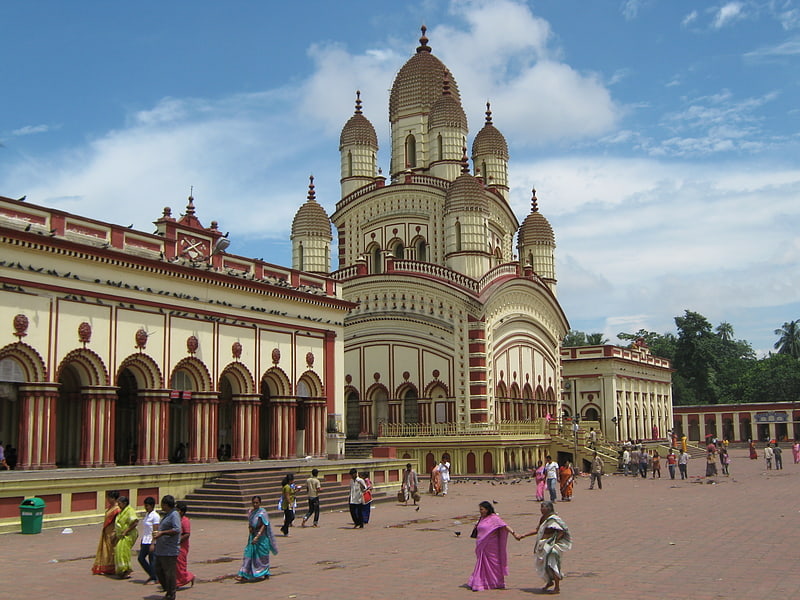
Also known as: दक्षिणेश्वर काली मन्दिर
Striking 19th-century spiritual complex. Dakshineswar Kali Temple is a Hindu navaratna temple located at Dakshineswar, Kolkata, West Bengal, India. Situated on the eastern bank of the Hooghly River, the presiding deity of the temple is Bhavatarini, a form of Parashakti Adya Kali, otherwise known as Adishakti Kalika. The temple was built in 1855 by Rani Rashmoni, a Zamindar, philanthropist and a devotee of Kali. The temple is known for its association with Ramakrishna and Ma Sarada Devi, mystics of 19th Century Bengal.
The main temple was inspired by Navaratna style Radhakanta temple, built by Ramnath Mondal of Tollygunge. The temple compound, apart from the nine-spired main temple, contains a large courtyard surrounding the temple, with rooms along the boundary walls. There are twelve shrines dedicated to Shiva—Kali's consort—along the riverfront, a temple to Radha-Krishna, a bathing ghat on the river, a shrine dedicated to Rani Rashmoni. 'Nahabat', the chamber in the northwestern corner just beyond the last of the Shiva temples, is where Ramakrishna and Maa Sarada spent a considerable part of their lives.[6]
Address: Near Bali Bridge, 700035 Kolkata (Calcutta)
Alipore Zoo
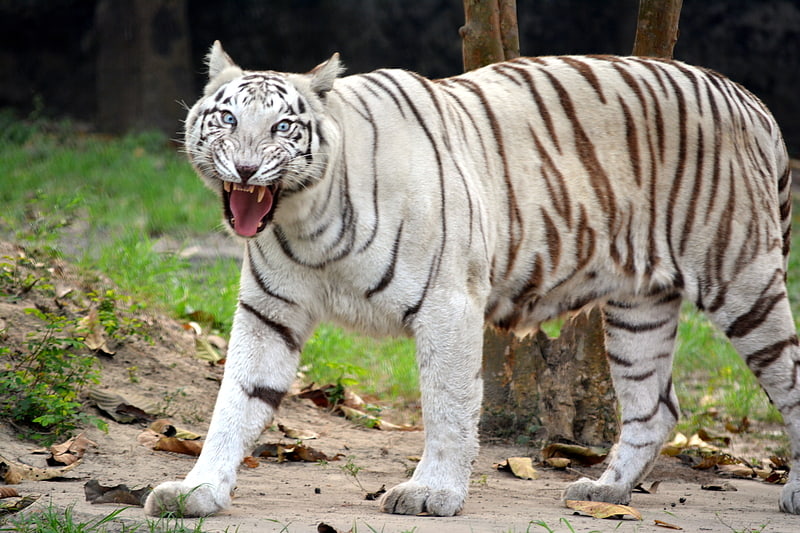
Also known as: अलीपुर वन्य प्राणी उद्यान
Long-running zoo with diverse animals. The Zoological Garden, Alipore is India's oldest formally stated zoological park and a big tourist attraction in Kolkata, West Bengal. It has been open as a zoo since 1876, and covers 18.811 ha. It is probably best known as the home of the now expired Aldabra giant tortoise Adwaita, who was reputed to have been over 250 years old when he died in 2006. It is also home to one of the few captive breeding projects involving the Manipur brow-antlered deer. One of the most popular tourist attractions in Kolkata, it draws huge crowds during the winter season, especially during December and January. The highest attendance till date was on January 1, 2018 with 110,000 visitors.[7]
Address: 2, Alipore Rd, 700027 Kolkata
Eden Gardens
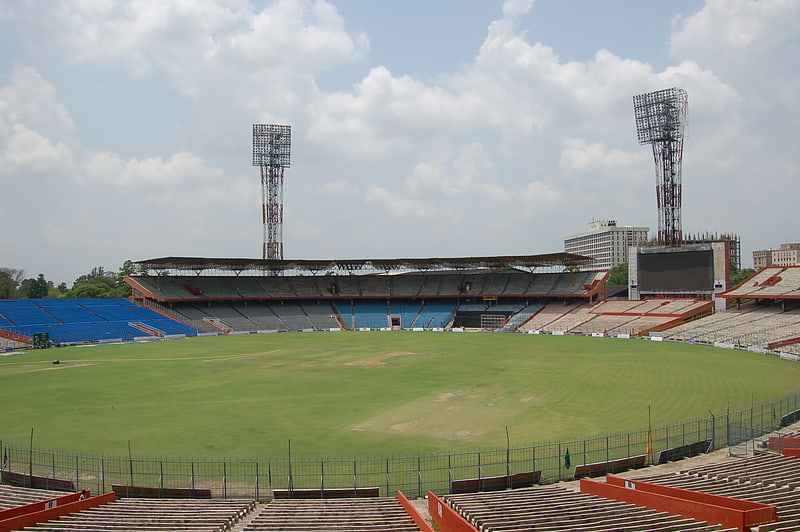
Also known as: इडेन गार्डेंस
Large-scale, 19th-century cricket ground. Eden Gardens is a cricket ground in Kolkata, India. Established in 1864, it is the oldest and second-largest cricket stadium in India and third-largest in the world. The stadium currently has a capacity of 68,000. On 22 November 2019, the venue hosted the first ever day/night Test match in India during the second Test between India and Bangladesh.
Eden Gardens is often referred to as home of Indian cricket. It has the fastest outfield of all the cricket stadiums in India, and is regarded as a "batsman's paradise". The ground has been referred to as "cricket's answer to the Colosseum". Eden Gardens is called the "Mecca of Indian cricket", due to it being the first officially built ground for the game of cricket in India. Eden Gardens has hosted matches in major international competitions including the World Cup, World Twenty20 and Asia Cup. In 1987, Eden Gardens became the second stadium to host a World Cup final. The 2016 ICC World Twenty20 final was held at the stadium, with the West Indies beating England in a closely fought encounter. Eden Gardens saw a record of crowd of 95,000 in 1987 Cricket World Cup Final.[8]
Address: Kolkata Centre, 700021 Kolkata (Calcutta)
Shobhabazar Rajbari
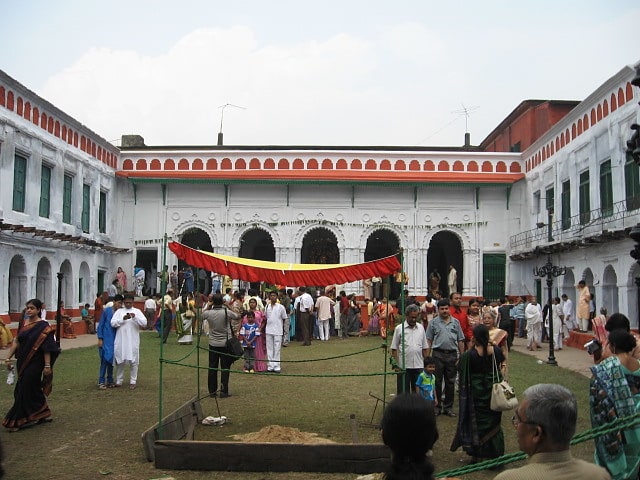
Heritage building in Kolkata, India. Shobhabazar Rajbari is the palace of the Shobhabazar royal family located in the Indian city of Kolkata.[9]
Address: Kolkata, 33 to 36 Raja Nabakrishna Street
Belur Math
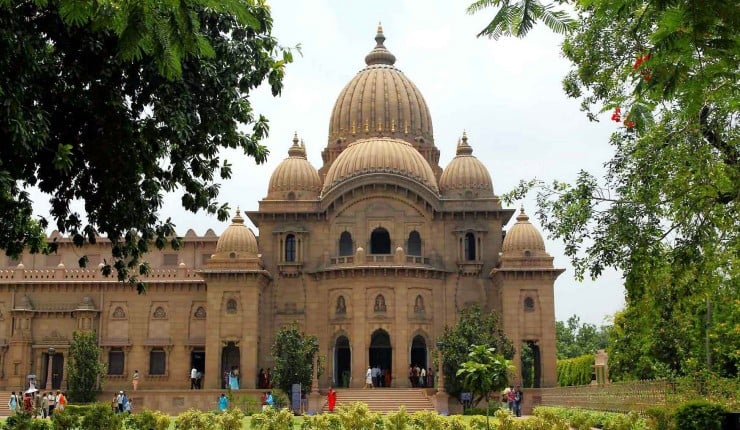
Also known as: बेलुड़ मठ
Temples and shrines dedicated to guru. Belur Math is the headquarters of the Ramakrishna Math and Ramakrishna Mission, founded by Swami Vivekananda, the chief disciple of Ramakrishna Paramahamsa. It is located on the west bank of Hooghly River, Belur, West Bengal, India and is one of the significant institutions in Kolkata. The temple is the heart of the Ramakrishna movement. It is notable for its architecture that fuses Hindu, Islamic, Buddhist, and Christian art and motifs as a symbol of unity of all religions. In 2003, Belur Math railway station was also inaugurated which is dedicated to Belur Math Temple.[10]
Address: Belur Rd, 711202 Belur
Salt Lake Stadium
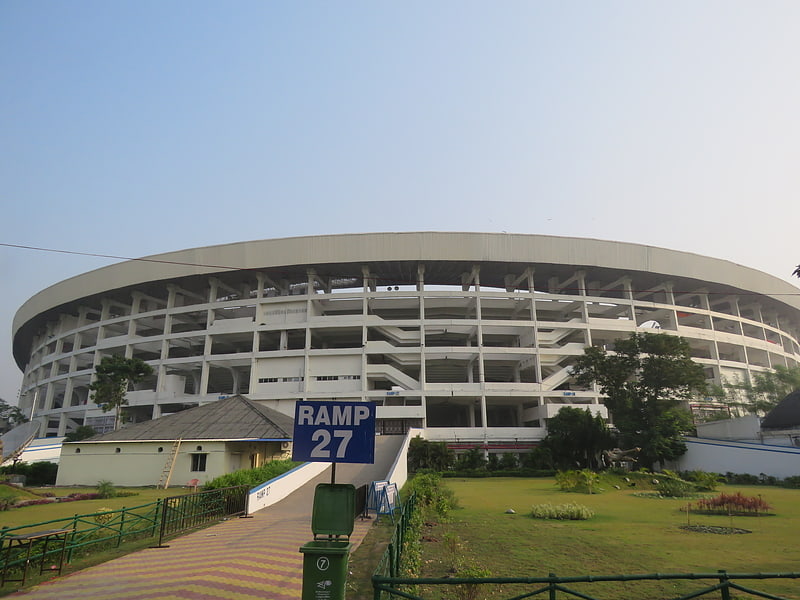
Also known as: युवा भारती क्रीडांगन
Stadium in India. The Salt Lake Stadium, officially the Vivekananda Yuba Bharati Krirangan, is an all-seater multipurpose stadium located in Bidhannagar with a current capacity of about 85,000 spectators. The Salt Lake Stadium is the main home ground of football clubs ATK Mohun Bagan, East Bengal and Mohammedan. It is the second largest stadium in India by seating capacity. Before its renovation in 2011, it was the largest football stadium in the world, having a seating capacity of 120,000. Prior to the construction and opening of Rungrado May Day Stadium in 1989, it was the largest football stadium in the world. The stadium hosted the final match of the 2017 FIFA U-17 World Cup, alongside hosting other matches of the tournament. As part of security measures for the 2017 U-17 World Cup, the stadium was only open for 66,687 viewers. It will be used again for the 2021 FIFA U-17 Women's World Cup.
The stadium's record attendance was recorded in 1997 when 131,781 spectators watched the Federation Cup semifinal between East Bengal and Mohun Bagan.
The stadium switched back to natural grass from artificial turf as part of the preparations for hosting the U-17 World Cup in 2017. The new turf was unveiled in a Kolkata Derby match between East Bengal and Mohun Bagan during the 2015–16 Calcutta Premier Division match.[11]
Address: JB Block, Salt Lake, 700098 Kolkata
Town Hall
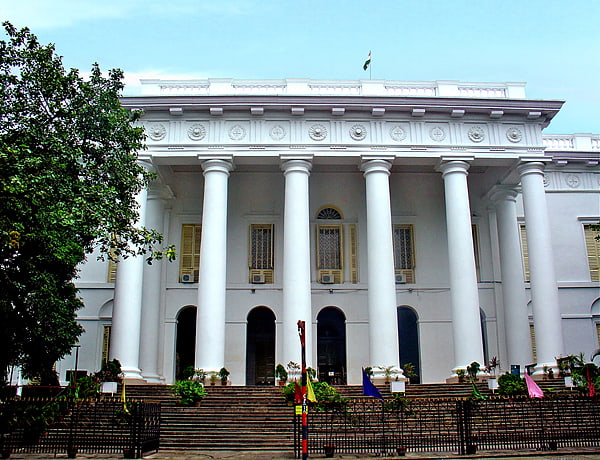
Kolkata Town Hall in Roman Doric style, was built in 1813 by the architect and engineer Major General John Henry Garstin with a fund of 700,000 Rupees raised from a lottery to provide the Europeans with a place for social gatherings.[12]
Address: Mayo Road, Maidan, Kolkata
Netaji Indoor Stadium

Sports arena in Kolkata, India. The Netaji Subhash Chandra Bose Indoor Stadium is an indoor sports arena in Kolkata, West Bengal, India. The facility seats 12,000 people. This indoor stadium is located just beside the Eden Gardens. It used to host the Sunfeast Open, a WTA Tour tennis tournament. Other international events hosted by the Stadium include the 1981 Asian Basketball Championship. Currently, it is the home of the Pro Kabaddi League team Bengal Warriors.
The Netaji Indoor Stadium hosts a wide range of activities, from sporting events to cultural programmes. It is a venue for both national and international trade fairs. It is also used as a center of counting of votes during elections.
The venue was inaugurated in 1975 by the then Chief Minister of West Bengal, Siddhartha Shankar Ray, for indoor games and cultural events, musical functions and other programmes.[13]
Nakhoda Mosque
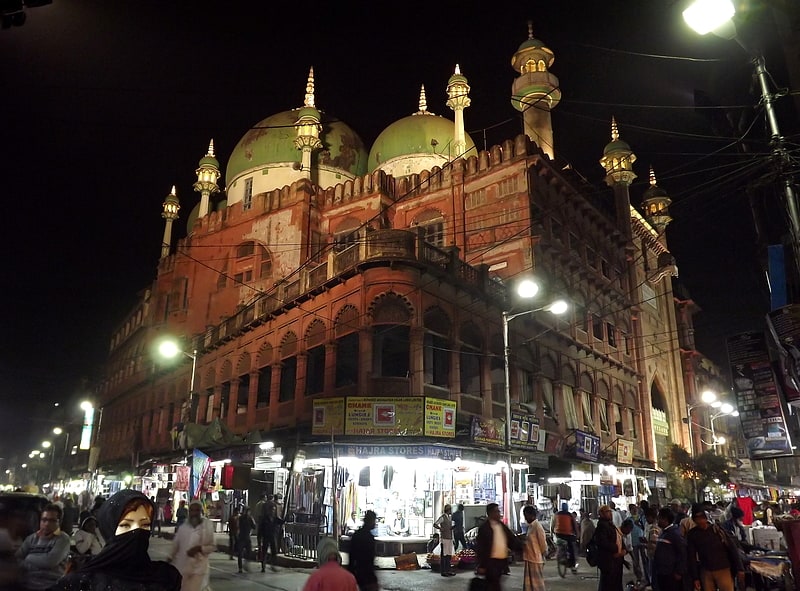
Mosque in Kolkata, India. The Nakhoda Mosque is the principal mosque of Kolkata, India, in the Chitpur area of the Burrabazar business district in Central Kolkata, at the intersection of Zakaria Street and Rabindra Sarani.[14]
Address: Mahatma Gandhi Rd & Rabindra Sarani, Kolkata
St. Paul's Cathedral

Eminent church dating from 1847. St. Paul's Cathedral is a Church of North India cathedral of Anglican background in Kolkata, West Bengal, India, noted for its Gothic architecture and dedicated to Paul the Apostle. It is the seat of the Diocese of Calcutta. The cornerstone was laid in 1839; the building was completed in 1847. It is said to be the largest church in Kolkata and the first Anglican cathedral in Asia. It was also the first new-built cathedral in the overseas territory of the British Empire. The edifice stands on Cathedral Road on the "island of attractions" to provide for more space for the growing population of the European community in Calcutta in the 1800s.
The architectural design of the cathedral is "Indo-Gothic", a Gothic architectural style designed to meet the climate of India. Following the 1897 earthquake and the subsequent massive earthquake of 1934, when Calcutta suffered substantial damage, the cathedral was reconstructed to a revised design. The cathedral complex has a library, situated over the western porch, and a display of plastic art forms and memorabilia.
Apart from that of Bishop Daniel Wilson, the founder of the cathedral, the other notable burial in the church is that of John Paxton Norman, an acting Chief Justice who was assassinated on the steps of Kolkata Town Hall in 1871.[15]
Address: 1A, Cathedral Road, 700071 Kolkata (Calcutta)
Shaheed Minar
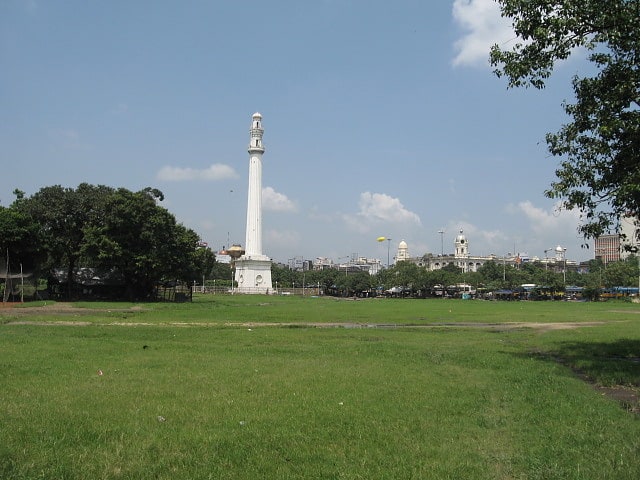
Also known as: शहीद मीनार, कोलकाता
Historical landmark in Kolkata, India. The Shaheed Minar, formerly known as the Ochterlony Monument, is a monument in Kolkata that was erected in 1828 in memory of Major-general Sir David Ochterlony, commander of the British East India Company, to commemorate both his successful defense of Delhi against the Marathas in 1804 and the victory of the East India Company’s armed forces over the Gurkhas in the Anglo-Nepalese War, also known as the Gurkha War. The monument was constructed in his memory. It was designed by J. P. Parker and paid for from public funds.
On 9 August 1969, it was rededicated to the memory of the martyrs of the Indian freedom movement and renamed the "Shaheed Minar," which means "martyrs' monument" in both Bengali and Hindi, by the then United Front Government in memory of the martyrs of the Indian independence movement. The present government has decided to illuminate the tower during evenings and allow visitors to the top. The last people to have been up there were former governor Gopal Krishna Gandhi and his family.[16]
Address: Kolkata, 11, Rani Rashmoni Avenue
Prinsep Ghat

Also known as: प्रिंसेप घाट
Tourist attraction in Kolkata, India. Prinsep Ghat is a ghat built in 1841 during the British Raj, along the Kolkata bank of the Hooghly River in India. The Palladian porch in the memory of the eminent Anglo-Indian scholar and antiquary James Prinsep was designed by W. Fitzgerald and constructed in 1843.
Located between the Water Gate and the St George's Gate of the Fort William, the monument to Prinsep is rich in Greek and Gothic inlays. It was restored by the state's public works department in November 2001 and has since been well-maintained. In its initial years, all royal British entourages used the Prinsep Ghat jetty for embarkation and disembarkation.
Prinsep Ghat is one of the oldest recreational spots of Kolkata. People visit it in the evenings on weekends to go boating on the river, stroll along the bank and purchase food from stalls there. A 2-kilometre (1.2 mi) stretch of the beautified riverfront from Prinsep Ghat to Babughat (Baje Kadamtala Ghat) was inaugurated on 24 May 2012. It has illuminated and landscaped gardens and pathways, fountains and renovated ghats. One of the songs in the Bollywood film Parineeta was shot here on the ghats.
Prinsep Ghat also has a railway station named after it. The station is part of the Kolkata Circular Railway which is maintained by Eastern Railway. The station code is PPGT.
There is a jetty nearby called the Man-O-War jetty that belongs to the Kolkata Port Trust and commemorates the role played by the port in the Second World War. The jetty is mainly used by the Indian Navy.[17]
Address: Strand Rd, Kolkata
Mahajati Sadan

Mahajati Sadan is an auditorium located on Chittaranjan Avenue in Kolkata, West Bengal, India. This auditorium is regularly used for Bengali theatres. Seminars are also organized in the seminal hall of Mahajati Sadan. This auditorium was an important part of India's freedom movement. Rabindranath Tagore called this auditorium "House of the Nation".[18]
Address: 166 Chittaranjan Ave, Kolkata
Birla Planetarium

Planetarium in Kolkata, India. The Birla Planetarium in Kolkata, West Bengal, India, is a single-storeyed circular structure designed in the typical Indian style, whose architecture is loosely styled on the Buddhist Stupa at Sanchi. Situated at Chowringhee Road adjacent to the Victoria Memorial, St. Paul's Cathedral and the Maidan in Central Kolkata, it is the largest planetarium in Asia and the second largest planetarium in the world. There are two other Birla Planetariums in India: B.M. Birla Planetarium in Chennai and the Birla Planetarium in Hyderabad.
Popularly known as taramandal, the planetarium was inaugurated on 2 July 1963 by the then Prime Minister of India, Jawaharlal Nehru. It has an electronics laboratory for design and fabrication of science equipment. It has an astronomy gallery that maintains a huge collection of fine paintings and celestial models of renowned astronomers. The Planetarium also has an astronomical observatory equipped with a Celestron C-14 Telescope with accessories such as ST6 CCD camera and solar filter. It offers to the public and students more than 100 astronomical projects dealing with various facts of astronomy, astro-physics, Space Science as well as myths concerning stars and planets. It has a capacity of 6800.
Daily programs are conducted in English, Bengali and Hindi from 12:00 to 19:00 hrs. The show timing is as follows: Mon to Sat - 12.30 PM HINDI, 1.30 PM ENGLISH, 2.30 PM HINDI, 3.30 PM BENGALI, 4.30 PM HINDI, 5.30 PM BENGALI, 6.30 PM ENGLISH and two extra shows on Sunday and Holiday is 10.30 AM HINDI, 11.30 AM BENGALI (updated on 15.08.2017) Programs are occasionally conducted in Odiya, Tamil and Gujarati, as well. Extra shows are arranged on holidays. The Planetarium was constructed by ML Dalmiya & Co. which is owned by Board of Control for Cricket in India former President late Jagmohan Dalmiya.
It reopened to public on 18 July 2017, after closing down for 28 months of renovations work. The new planetarium system for the Birla Planetarium is a so-called ZEISS Hybrid Planetarium, with the STARMASTER, an optical-mechanical planetarium projector (also called “Starball”) working in synch with a dome video display system. The Starball presents the most realistic starfield in the dome with superimposed images of constellation outlines, space objects like nebula and galaxies, planets and moons by the VELVET digital video system, called fulldome projection. The technical upgrade was delivered and installed by the German company Carl Zeiss AG.[19]
Address: M.P.Birla Planetarium : - 96, Jawaharlal Nehru Road Kolkata-700071, Kolkata
Vidyasagar Setu
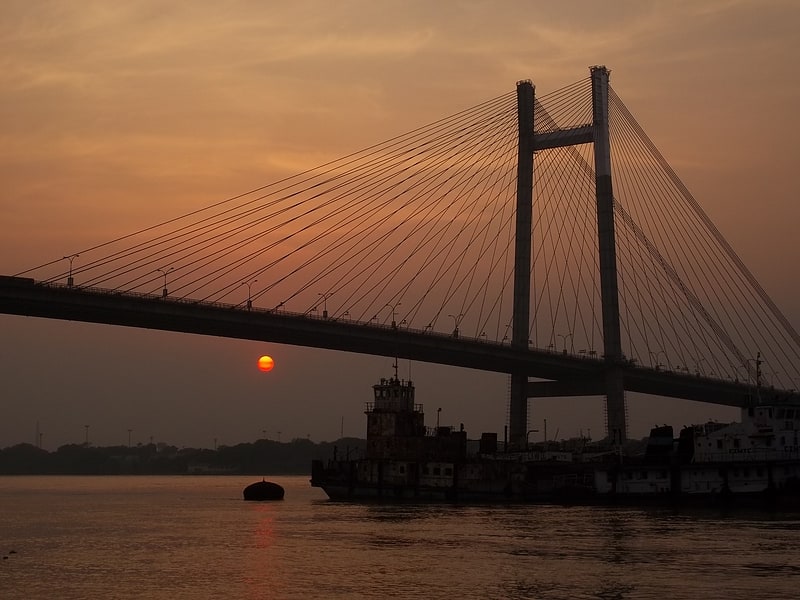
Also known as: विद्यासागर सेतु
Landmark cable-stayed bridge. Vidyasagar Setu, also known as the Second Hooghly Bridge, is a toll bridge over the Hooghly River in West Bengal, India, linking the cities of Kolkata and Howrah.
Opened in 1992, with a total length of 823 metres (2,700 ft), Vidyasagar Setu is the first and longest cable-stayed bridge in India. It was the second bridge to be built across the Hooghly River; the first, the Howrah Bridge (also known as Rabindra Setu) 3.7 kilometres (2.3 mi) to the north, was completed in 1943. Named after the educationist reformer Pandit Ishwar Chandra Vidyasagar, it cost ₹3.88 billion to build. The project was a joint effort between the public and private sectors, under the control of the Hooghly River Bridge Commissioners (HRBC).
The importance of the bridge has increased manifold since 2013, as the West Bengal State Secretariat had shifted it's office to Nabanna, located adjacent to the bridge on the Howrah side.
Initially, under the toll collection regime of the HRBC, daily traffic was recorded to be a minimum of 28,000 vehicles and a maximum of 39,000 vehicles in 2000, but fell to a maximum of around 30,000 vehicles by December 2002, when the management of the toll plaza was handed over to a private firm. Subsequently, the daily traffic reached a minimum of 45,000 vehicles and a maximum of 61,000 vehicles by early 2008, against a maximum capacity of 85,000 vehicles per day. The original management of the toll revenue collection by HRBC was consequently criticized for corruption and significant loss of revenue.[20]
Experimenter Gallery
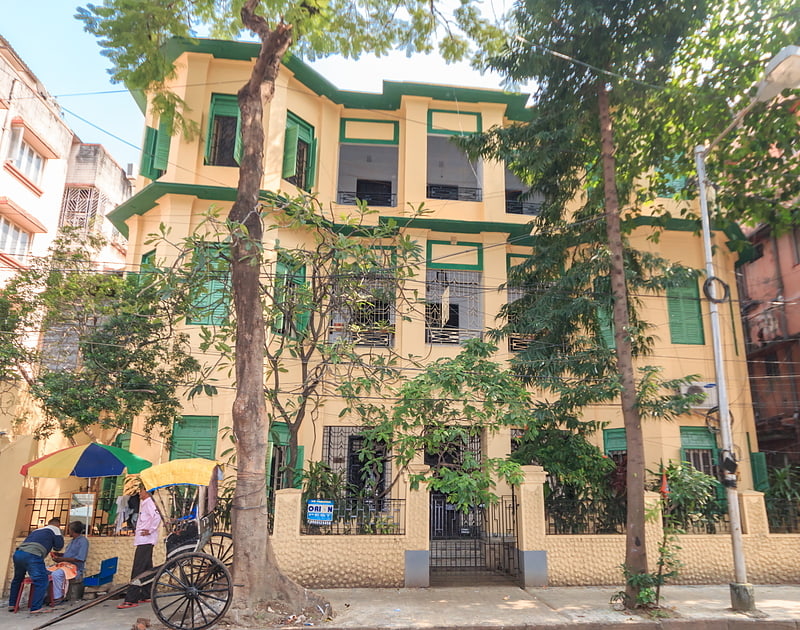
Experimenter is a contemporary art gallery co-founded by Priyanka and Prateek Raja in Kolkata. It represents several important artists in the contemporary art scene from across the globe. The gallery functions as an incubator for contemporary art practice spread across various disciplines and media.
The program of the gallery is known for nurturing a space that encourages dialogue, dissent and fearless expression through artistic experiments. In addition to exhibition-making, Experimenter’s programmes encompass a wide range of initiatives that focus on knowledge creation and dissemination through publishing, learning programs, talks, workshops, and performances. Its widely acclaimed annual Experimenter Curator’s Hub brings together curators from across the world to discuss and debate curatorial practices.
In 2016, the gallery launched its publishing wing, Experimenter Books that devotes itself to artist-book publication. The gallery started the Experimenter Learning Program (ELP) in 2018 that facilitates learnings in fields of contemporary and performing arts, curatorship, writing, film and social culture where the audiences actively engage with the gallery beyond passive viewership. On its 10th anniversary in 2019, the gallery started its most recent initiative, Experimenter – Outpost where it moves outside its physical gallery spaces to hold exhibitions in disused spaces as an exploration of the possibility of a renewed life for them.[21]
Tipu Sultan Mosque
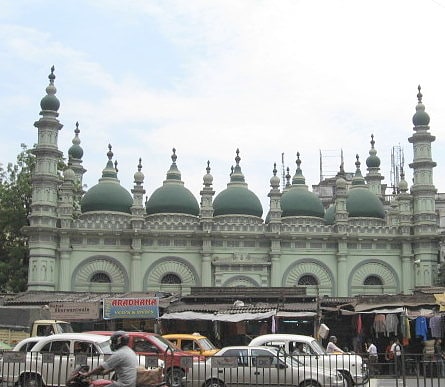
Mosque in Kolkata, India. The Tipu Sultan Shahi Mosque is a famous mosque in Kolkata, India named after Tipu Sultan the ruler of Mysore. Located at 185 Dharamtalla Street, the mosque is a relic of architectural and cultural heritage.[22]
Address: 185 Dharmatala Street (now Lenin Sarani), Kolkata
Raj Bhavan
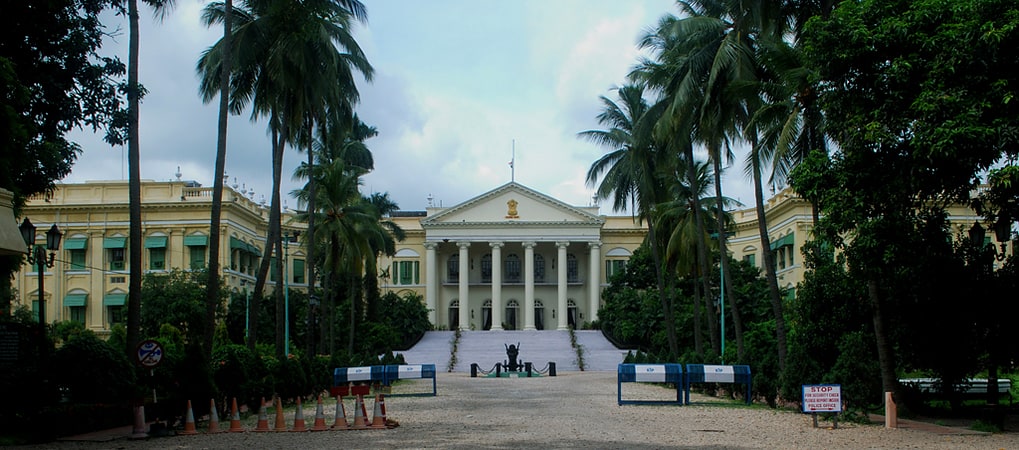
Also known as: राजभवन , कोलकाता
Government office in Kolkata, India. Raj Bhavan is the official residence of the governor of West Bengal, located in Kolkata, the capital of the Indian state of West Bengal. Built in 1803, it was known as Government House before the Indian independence.
After the transfer of power from the East India Company to the British Crown in 1858, it became the official residence of the Viceroy of India, moving here from the Belvedere Estate. With the shifting of the British Indian capital from then Calcutta to Delhi in 1911, it became the official residence of Lieutenant Governor of Bengal. Since independence in 1947 it serves as the official residence of the Governor of West Bengal and came to be known as the Raj Bhavan, a name it shares with the official residences of other states' governors.[23]
Maidan
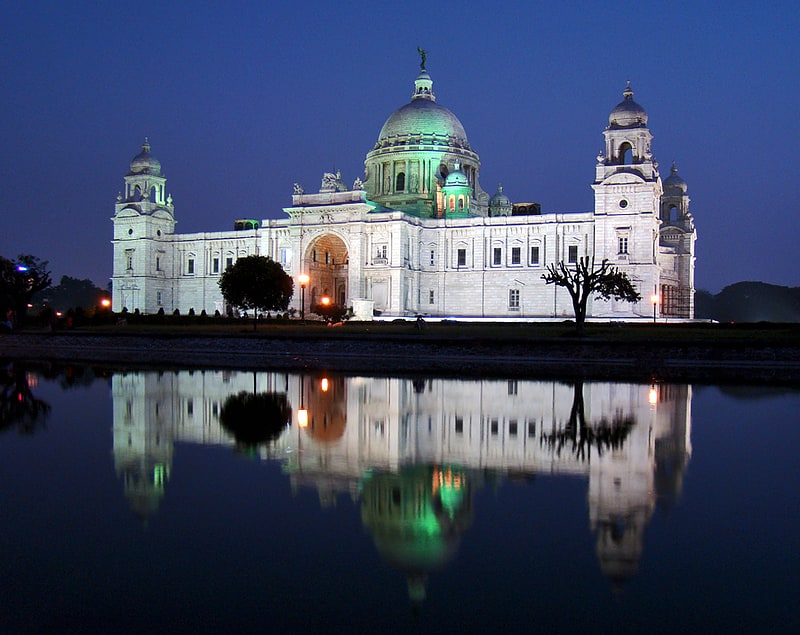
Also known as: मैदान, कोलकाता
Park in Kolkata, India. The Maidan, also referred to as the Brigade Parade Ground, is a large public park and urban green space in the center of Kolkata, India. With a total area of 988 acres, it is the largest urban park in Asia. It is a vast stretch of field that includes numerous sporting grounds, including the famous cricketing venue Eden Gardens, several football stadiums and the Kolkata Race Course. The Maidan is also dotted with many statues and architectural works, the most notable being the Victoria Memorial. Due to the freshness and greenery it provides to the metropolis, it has been referred to as the "lungs of Kolkata".
The property of the Indian Army, the Maidan hosts the army's Eastern zone high command in historic Fort William. The Maidan stretches from the Raj Bhavan building on the Esplanade in the north to the National Library on Belvedere Road in Alipore in the south. The wide field stretches from the Hooghly River in the west to the Victoria Memorial in the east. The park is considered the historical and cultural center of Kolkata, as well as one of the city's most popular tourist attractions and a hub of leisure and entertainment for Calcuttans.[24]
Address: Jawaharlal Nehru Rd, 700071 Kolkata
Magen David Synagogue
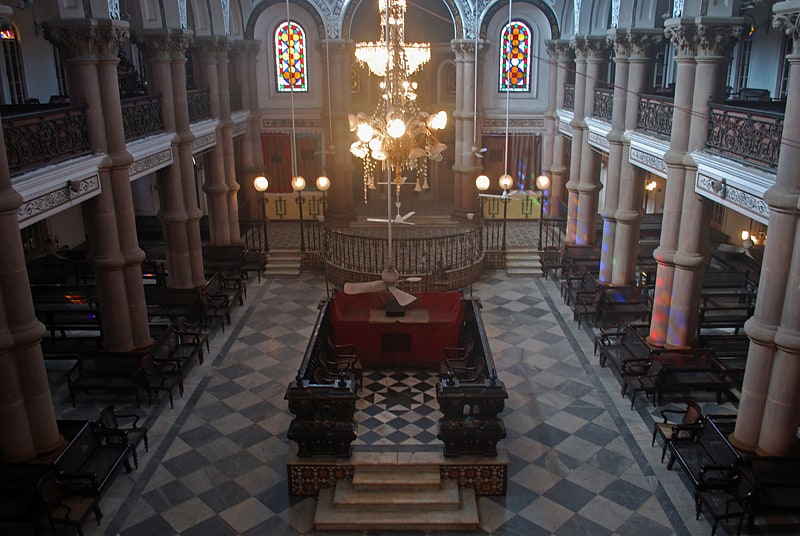
Synagogue in Kolkata, India. Magen David, or the Shield of David, Synagogue is located at the junction of Brabourne Road and Canning Street in Kolkata. Magen David is the second operating synagogue in Kolkata, the other is the Beth El Synagogue at Pollock Street.[25]
Address: 19, Synagogue St, 700001 Kolkata
The Asiatic Society
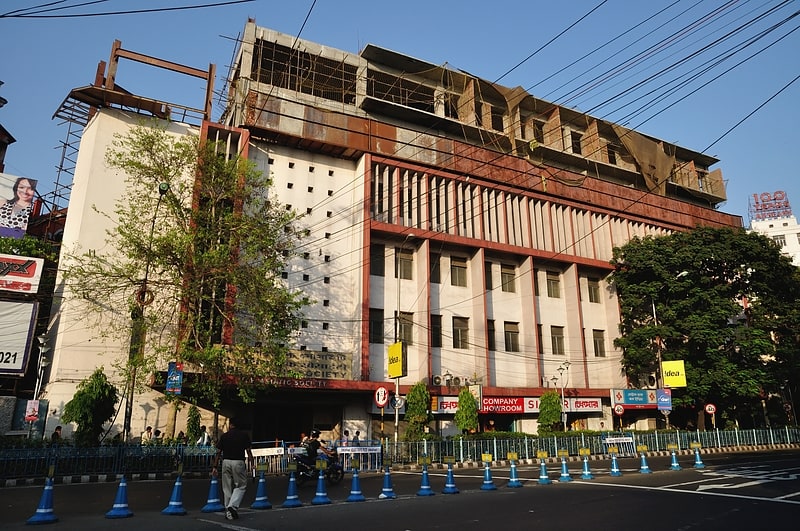
Also known as: एशियाटिक सोसायटी
Research foundation in Kolkata, India. The Asiatic Society is a government of India organisation founded during the Company rule in India to enhance and further the cause of "Oriental research", in this case, research into India and the surrounding regions. It was founded by the philologist William Jones on 15 January 1784 in a meeting presided over by Justice Robert Chambers in Calcutta, the then-capital of the Presidency of Fort William.
At the time of its foundation, this Society was named as "Asiatick Society". In 1825, the society was renamed as "The Asiatic Society". In 1832 the name was changed to "The Asiatic Society of Bengal" and again in 1936 it was renamed as "The Royal Asiatic Society of Bengal". Finally, on 1 July 1951, the name of the society was changed to its present one. The Society is housed in a building at Park Street in Kolkata (Calcutta). The Society moved into this building during 1808. In 1823, the Medical and Physical Society of Calcutta was formed and all the meetings of this society were held in the Asiatic Society.[26]
Address: A J C Bose Road, 700016 Kolkata
Holy Rosary Cathedral
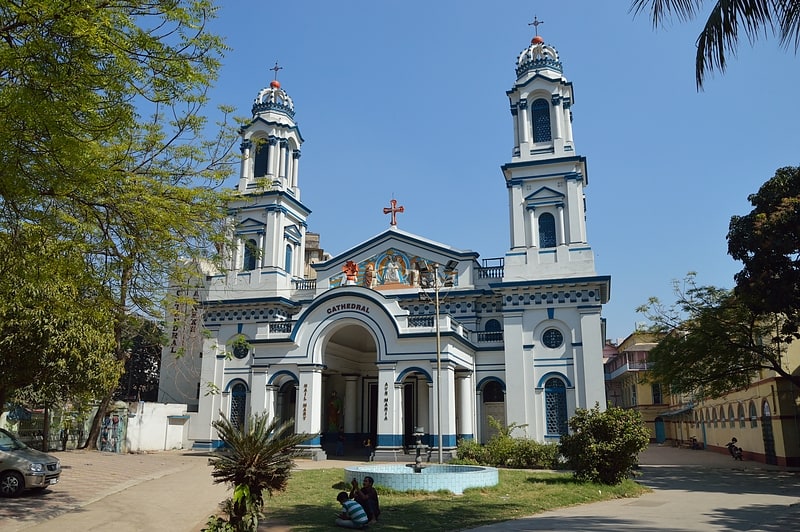
Cathedral in Kolkata, India. The Cathedral of the Most Holy Rosary in Burrabazar, Kolkata, is the cathedral of the Roman Catholic Archdiocese of Calcutta. It is also known as the Murgihata Church and was founded in 1799.
The cathedral has a decorated pediment, flanked on either side by two domed towers and an extended portico with arched entrance way. The interior contains beautiful sculptures including 14 Stations of the Cross. Behind the altar, there are the figures of Madonna and Child. The remains of the first Archbishop of Calcutta lie below the altar.[27]
Address: Portuguese Church Street, 700007 Kolkata
Armenian Church of the Holy Nazareth
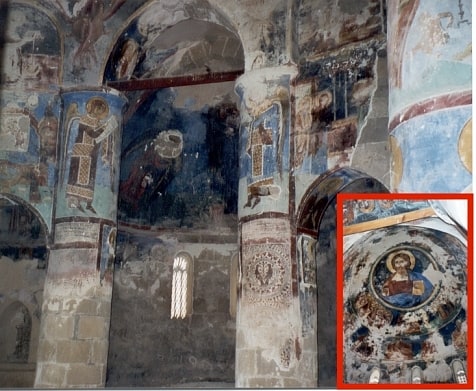
Church in Kolkata, India. The Armenian Holy Church of Nazareth is an 18th-century Armenian Apostolic church in Kolkata, India, serving as the centre of the Armenian Community in Kolkata and the seat of the Armenian Vicariate of India and the Far East. It is affiliated with the Mother See of Holy Etchmiadzin of the Armenian Apostolic Church. It was first built in the year 1688 and rebuilt in 1724 on the old cemetery of the Armenian community, through the efforts of Agha Nazar after the original wooden structure perished in a fire in 1707.[28]
Address: Bortola, Barabazar Market, 700001 Kolkata
Kalighat Kali Temple
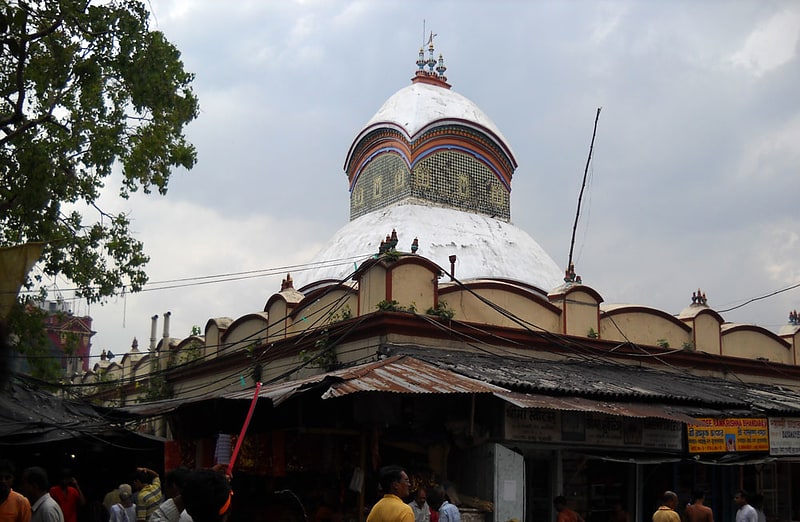
Also known as: कालीघाट शक्तिपीठ
Hindu temple in Kolkata, India. Kalighat Kali Temple is a Hindu temple in Kalighat, Kolkata, West Bengal, India dedicated to the Hindu goddess Kali. It is one of the 51 Shakti Peethas.
Kalighat was a Ghat (landing stage) sacred to Kali on the old course (Adi Ganga) of the Hooghly river (Bhāgirathi) in the city of Kolkata. The name Kolkata is said to have been derived from the word Kalikata devi of Kalighat Temple. The river over a period of time has moved away from the temple. The temple is now on the banks of a small canal called Adi Ganga which connects to the Hooghly. The Adi Ganga was the original course of the river Hooghly. Hence the name Adi (original) Ganga.[29]
Address: Kali Temple Rd, 700026 Kolkata
Ramakrishna Mission Swami Vivekananda's Ancestral House and Cultural Centre
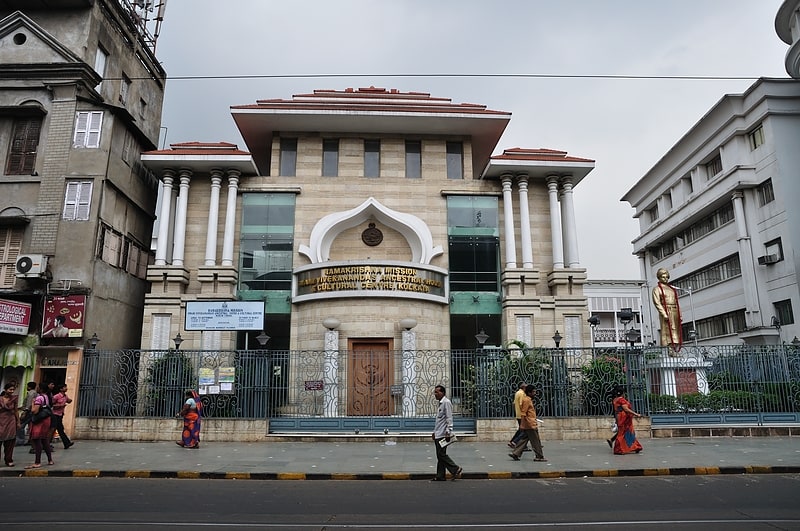
Museum in Kolkata, India. Ramakrishna Mission Swami Vivekananda's Ancestral House and Cultural Centre is a museum and cultural centre. It is located at 105 Vivekananda Road, Kolkata, India. In this house, Swami Vivekananda was born on 12 January 1863. The house remained Vivekananda's home throughout his childhood and early youth. The cultural centre was inaugurated by the President of India A. P. J. Abdul Kalam.[30]
Address: Kolkata, 105 Vivekananda Road
Lake Kalibari
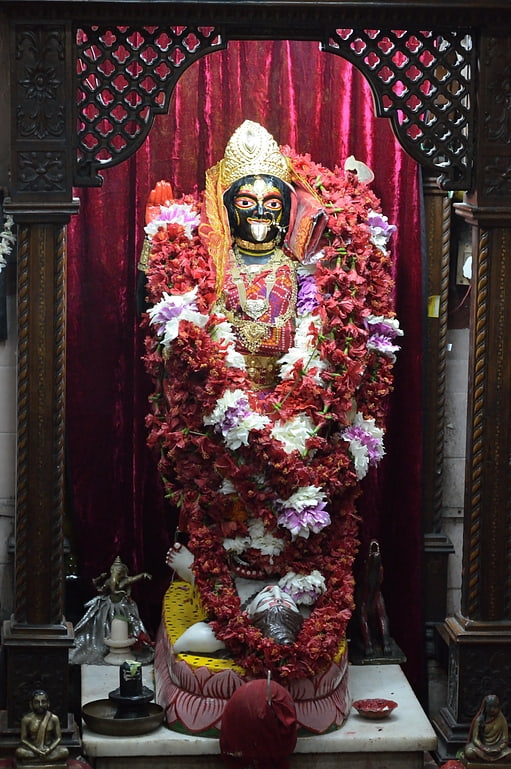
Hindu temple in Kolkata, India. Lake Kalibari is a Kali temple located at Southern Avenue in Kolkata, West Bengal, India. The official name of the temple is Sree Sree 108 Karunamoyee Kalimata Mandir after the name presiding deity Karunamoyee. The temple is managed by the Sree Sri Karunamoyee Kalimata Trust. The temple is undergoing reconstruction since 2002 and is due to be completed by 2013 but due to financial issues it has still not completed.[31]
Acharya Jagadish Chandra Bose Indian Botanic Garden

Botanic gardens with a lake and rare trees. The Acharya Jagadish Chandra Bose Indian Botanic Garden, previously known as Indian Botanic Garden and the Calcutta Botanic Garden, is situated in Shibpur, Howrah near Kolkata. They are commonly known as the Calcutta Botanical Garden and previously as the Royal Botanic Garden, Calcutta. The gardens exhibit a wide variety of rare plants and a total collection of over 12,000 specimens spread over 109 hectares. It is under Botanical Survey of India of Ministry of Environment and Forests, Government of India.[32]
South Park Street Cemetery
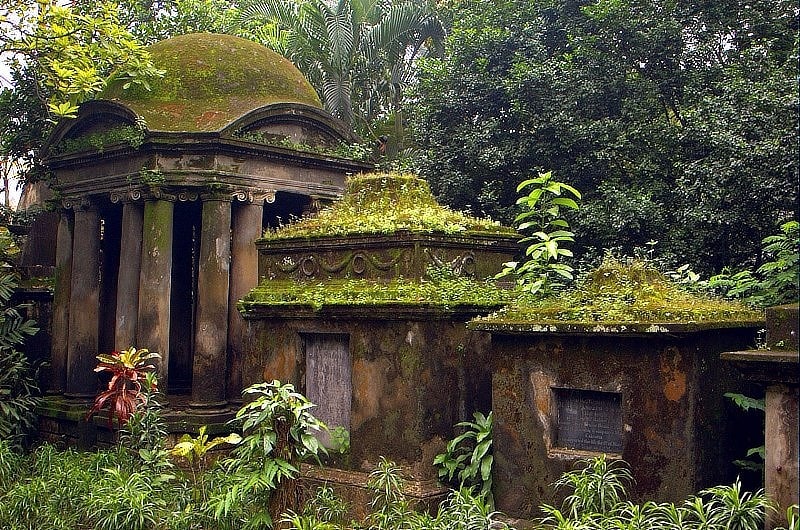
Burial ground. South Park Street Cemetery is located on Mother Teresa Sarani, Kolkata, India. The road used to be called Park Street, and prior to that Burial Ground Road.[33]
Shobhabazar Lal Mandir

The Lal Mandir is an old Hindu temple in the locality of Shobhabazar, at the crossing of Raja Nabakrishna Street and Jyotindra Mohan Avenue of Kolkata, India. It is said to be built by the Raja of Shobhabazar. It is located near Sobhabazar Metro Station entrance.[34]
The Great Banyan
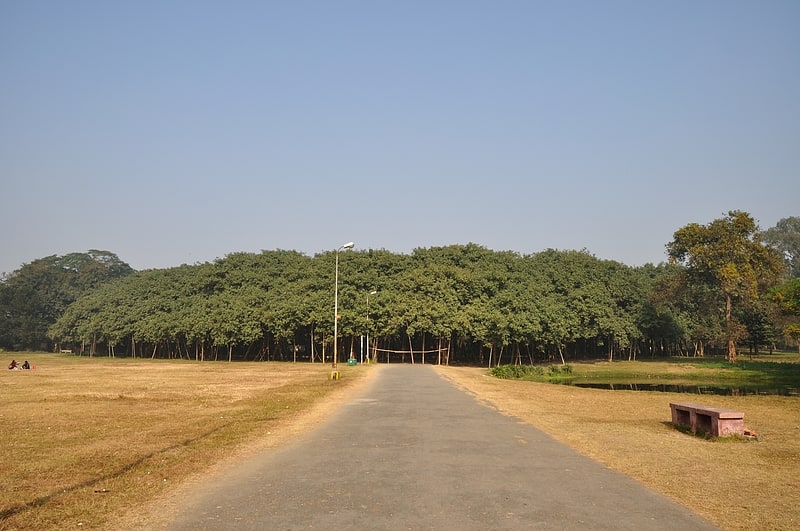
The Great Banyan is a banyan tree located in Acharya Jagadish Chandra Bose Indian Botanic Garden, Shibpur, Howrah, near Kolkata, India. The great banyan tree draws more visitors to the garden than its collection of exotic plants from five continents. Its main trunk became diseased after it was struck by two cyclones, so in 1925 the main trunk of the tree was amputated to keep the remainder healthy. A 330-metre-long road was built around its circumference, but the tree continues to spread beyond it.
It was recorded to be the largest tree specimen in the world in the Guinness Book of World Records in 1989.[35]